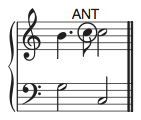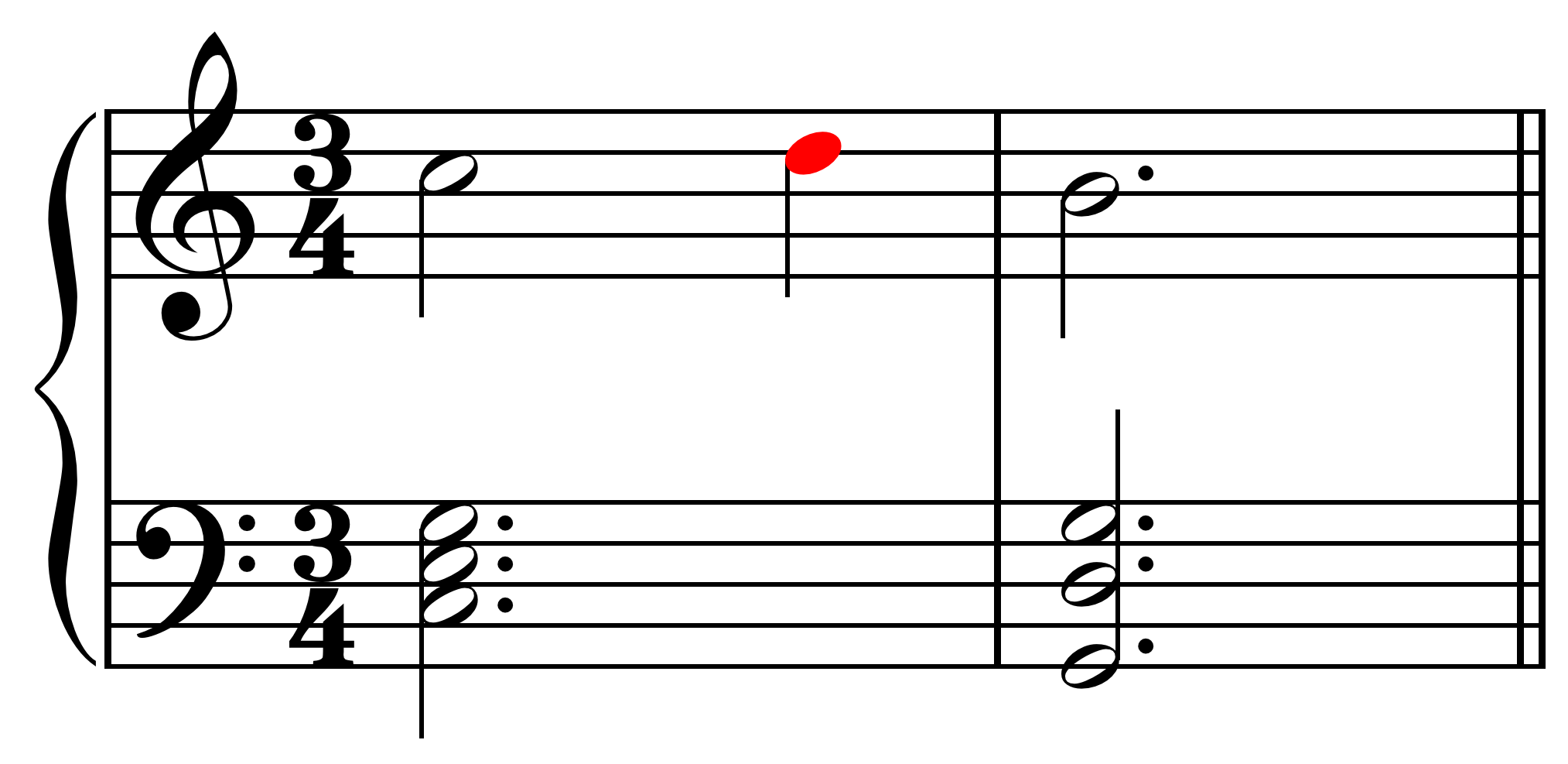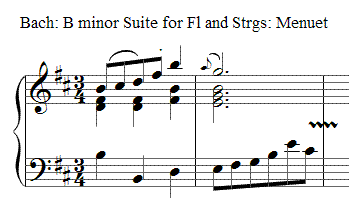6.3 Embellishing Tones: Identifying Anticipations, Escape Tones, Appoggiaturas, and Pedal Points
7 min read•june 18, 2024
Sumi Vora
AP Music Theory 🎶
72 resourcesSee Units
Passing tones and neighbor tones are not the only ways to create melodic interest in a piece. There are some cases where we don’t want the melodic line to move stepwise – if it only moved by step for the whole piece, that would be quite boring. There are a few different types of non-chord tones that allow the melodic line to move by leap. Specifically, in this section, we will learn about anticipation tones, escape tones, appoggiaturas, and pedal points.
Anticipation Tones
Anticipation tones are chord tones that come a little bit before a change in harmony. For example, if you are moving from a V-I in a perfect authentic cadence, you might introduce the tonic in the soprano line an eighth note before the harmonic beat, when the rest of the chord tones come in.
Anticipation tones are almost always dissonant, meaning that they add tension to the piece right before it resolves. This is because when you try adding a chord tone of a different chord, you will have at least one dissent interval. For example, if we are in C Major in the example above, there will be a Major 2nd between the D in the G Major chord and the C in the anticipation tone, which will introduce a dissonant interval.
Anticipation tones can add a sense of rhythmic or harmonic tension and create a sense of forward motion in the music. They can also be used to create a sense of surprise, dissonance or dissonant-sounding and can be used to create a sense of surprise or dissonance in a piece of music. For that reason, anticipation tones are usually most effective and often used at the end of phrases or sections of music – right before a big resolution happens.
Because anticipation tones occur before the harmonic beat by definition, they are necessarily unaccented non-chord tones. This is one way in which they differ from suspensions, which we will learn in Unit 6.4.
Here is an example of an anticipation tone:

Image via http://elliotthauser.com/openmusictheory/embellishingTones.html
Escape Tones
Escape tones are similar to neighbor tones, which we learned about in the last unit. As a review, a neighbor tone in music is a non-chord tone that is played or sung immediately before or after a chord tone within a melody or harmony. Neighbor tones are used when a chord tone is sustained from one chord to another, meaning that the note in the voice stays the same for both chords. In this case, adding a neighbor tone means adding a note above or below the sustained note. For example, if there is a C in the soprano voice that is sustained for two chords, you can step down such that you have a C-B-C melody in the soprano voice.
Escape tones are like incomplete neighbor tones: you will move stepwise from the chord tone preceding it, but you will move by skip or leap (usually in the opposite direction of the escape tone) to the resolution of this non-chord tone.
Escape tones can be classified into two categories: upper and lower. Upper escape tones occur when the escape tone moves up stepwise following the chord tone in the preparation, while lower escape tones occur when the escape tone moves down stepwise following the chord tone in the preparation. Both types of escape tones can add a sense of tension and dissonance to a melody, and can be used to create a sense of movement and resolution.
Here is an example of an escape tone:

Image via Wikipedia
Note that it is considered bad voice leading to resolve an escape tone in the same direction of the non-chord tone. In other words, you should resolve an upper escape tone with a skip or leap downwards, and a lower escape tone with a skip or leap upwards. This is generally a good rule to follow when writing non-chord tones that don’t resolve stepwise.
The only exception is an arpeggiation of a chord, in which the melodic embellishment is a member of both the diatonic chords in the preparation and the resolution. For example, when moving from a I chord to a I6 chord, where there is a C in the soprano line in the I chord, and a G in the soprano line in the I6 chord, it would be appropriate to insert an E in between these two chord tones to arpeggiate the tonic chord. However, this E would not be considered a non-chord tone, since it is a part of both the I and I6 chords, and it is a member of this tonic harmony overall!
Just like other non-chord tones, escape tones can also be used to create a sense of surprise and tension. This can be achieved by using unexpected chord progressions or by using dissonant harmonies. For example, using a chord progression that goes against the natural harmonic progression of a piece of music can create a sense of tension and dissonance. This can be used to create a sense of surprise and tension, and can be used to create a sense of movement and resolution.
Appoggiaturas
Appoggiaturas, also known as grace notes, are a type of non-chord tone that are used to add dissonance and tension to a melody. They are typically played just before a chord tone and are often used to create a sense of movement and resolution. Appoggiaturas are a common feature in both classical and popular music, and can be played on any instrument.
Appoggiaturas can be classified into two categories: short and long. Short appoggiaturas are played for a very short duration, and they are usually considered to take up no rhythmic time. They are typically used to add a sense of dissonance and tension to a melody. Long appoggiaturas, on the other hand, are played for a longer duration, and there might be multiple notes involved. They are typically used to create a sense of movement and resolution.
Appoggiaturas can also be classified into two types: dissonant and consonant. Dissonant appoggiaturas are played on a note that is not part of the chord, while consonant appoggiaturas are played on a note that is part of the chord. Dissonant appoggiaturas are typically used to add a sense of dissonance and tension to a melody, while consonant appoggiaturas are typically used to create a sense of movement and resolution.
Appoggiaturas are a type of ornamentation in music. Ornamentation is the use of appoggiaturas, trills, and other grace notes to add interest and variety to a melody. Ornamentation can be used to create a sense of dissonance and tension, and can be used to create a sense of movement and resolution.
There is significant debate in the musical community about whether appoggiaturas are meant to be played before the beat or after the beat. Usually, this depends on the type of piece, when it was written, and the musical context around the piece. However, we usually hear grace notes before the beat, since they are considered to have no rhythmic time.
Here is an example of an appoggiatura. It is the tiny eighth note on in the second bar.

Image via harmony.org
Pedal Points
Pedal points, also known as pedal tones, are a type of prolonged note or chord that is held under a changing harmony. They are typically played on a lower-pitched instrument, such as a bass guitar, piano or organ and are often used to create a sense of tension and dissonance. Pedal points are a common feature in both classical and popular music, and can be played on any instrument.
Here is an example of a pedal point:

Image via Music Theory Academy
Pedal points can be classified into two categories: harmonic and non-harmonic. Harmonic pedal points are notes or chords that are held for an extended period of time and are part of the chord progression. Non-harmonic pedal points, on the other hand, are notes or chords that are held for an extended period of time but are not part of the chord progression. They are used to create tension and dissonance.
One of the most common ways that pedal points are used in music is to create a sense of tension and dissonance. This can be achieved by using a pedal point that is not part of the chord progression. For example, holding a note or chord that is not part of the chord progression can create a sense of dissonance and tension. They are sometimes considered to have an eerie sound. If you listen to Chopin’s Ballade No 1, for example, pedal points are often used before modulations or other intense parts of the passage. Here is a good video explaining pedal points in this piece.
In classical music, pedal points are often used in fugues, where a single note or chord is held throughout the piece as a background for the main theme. It creates a sense of continuity and stability and serves as a foundation for the complex counterpoint of the fugue.
🦜 Polly wants a progress tracker: Write a simple T-PD-D-T chord progression, and insert at least three of the following in either the soprano or bass lines: passing tones, neighbor tones, anticipation tones, escape tones, appoggiaturas, and pedal points. Remember to use all of the correct voice leading rules for both chord and non-chord tones!
Browse Study Guides By Unit
🎵Unit 1 – Music Fundamentals I (Pitch, Major Scales and Key Signatures, Rhythm, Meter, and Expressive Elements)
🎶Unit 2 – Music Fundamentals II (Minor Scales and Key Signatures, Melody, Timbre, and Texture)
🎻Unit 3 – Music Fundamentals III (Triads and Seventh Chords)
🎹Unit 4 – Harmony and Voice Leading I (Chord Function, Cadence, and Phrase)
🎸Unit 5: Harmony and Voice Leading II: Chord Progressions and Predominant Function
🎺Unit 6 – Harmony and Voice Leading III (Embellishments, Motives, and Melodic Devices)
🎤Unit 7 – Harmony and Voice Leading IV (Secondary Function)
🎷Unit 8 – Modes & Form
🧐Exam Skills
📚Study Tools

Fiveable
Resources
© 2025 Fiveable Inc. All rights reserved.